The global Operating Room Supplies Market is projected to reach a valuation of USD 8,123.8 million by 2025 and is expected to grow to USD 11,683.0 million by 2035. This reflects a total increase of USD 3,559.2 million over the ten-year period. The market is anticipated to expand at a CAGR of 3.7%, representing a 1.44X growth from 2025 to 2035. This growth is fueled by rising surgical procedure volumes, increasing adoption of technologically advanced surgical tools, and the global focus on improving healthcare infrastructure and patient safety.
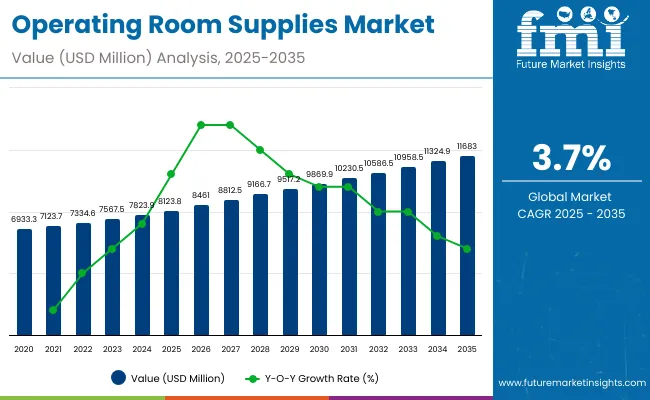
| Metric | Value |
|---|---|
| Industry Size (2025E) | USD 8,123.8 million |
| Industry Value (2035F) | USD 11,683.0 million |
| CAGR (2025 to 2035) | 3.7% |
During the first half of the forecast period (2025 to 2030), the Operating Room Supplies Market is projected to expand from USD 8,123.8 million to USD 9,927.0 million, marking an absolute growth of USD 1746.1 million. This accounts for 49.1% of the total projected decade-long growth (2025-2035), underscoring strong early momentum driven by surgical volume recovery, post-pandemic capacity building, and increased capital expenditure in healthcare facilities. Ceiling-mounted Surgical Lights are expected to maintain dominance within the Surgical & Exam Lights category, rising from 22.4% in 2025 to 24.3% in 2035, reflecting hospitals’ preference for fixed, high-lumen lighting solutions in hybrid and modular OR setups.
During the second half from 2030 to 2035, the Operating Room Supplies Market is projected to grow from USD 9,742.1 million to USD 11,683.0 million, contributing USD 1813.2 million, which equals 50.9% of the total decade growth. This acceleration is fueled by the widespread adoption of advanced surgical equipment and integrated OR systems across hospitals and ambulatory care centers.
From 2020 to 2024, the global Operating Room Supplies Market grew from USD 6,933.3million to USD 7,823.9 million, reflecting a steady increase in demand across hospitals and ambulatory surgical centers. This growth was driven by a global rebound in elective procedures and sustained investments in surgical infrastructure, particularly in North America and Western Europe. Leading manufacturers such as Getinge, STERIS, and Baxter collectively captured nearly 50% of the premium market segments, primarily through bundled solutions encompassing surgical tables, lighting systems, and sterile consumables. These players have adopted key strategies including integration of hybrid OR platforms, modular surgical system design, and strategic collaborations with hospitals and clinical engineers to improve operating room workflow efficiency and infection control outcomes.
In 2025, the Operating Room Supplies Market is projected to reach a value of approximately USD 8,123.8 million, driven by the transition from conventional surgical setups to digitally enabled, workflow-centric operating environments. This growth is underpinned by rising global surgical volumes, expansion of ambulatory surgery centers (ASCs), and healthcare facilities’ increasing focus on efficiency, sterility, and regulatory compliance.
Hospitals and surgical centers are accelerating investments in advanced OR infrastructure, such as integrated surgical lights, automated operating tables, and real-time patient monitoring systems, to enhance procedural throughput and meet stringent clinical standards. The emphasis on infection prevention and perioperative staff safety is also boosting demand for disposable consumables, sterilization tools, and electrosurgical equipment.
Operating Room Supplies are experiencing steady global growth as healthcare systems respond to rising surgical demand, greater emphasis on infection prevention, and the need for workflow efficiency and ergonomic safety in high-pressure environments. Key drivers include stricter regulatory compliance standards, such as infection control mandates, growing adoption of minimally invasive and robotic-assisted surgeries, and persistent staffing shortages in surgical and perioperative departments.
Hospitals and surgical centers are increasingly investing in integrated OR infrastructure including ceiling-mounted surgical lights, advanced monitoring systems, modular operating tables, and sterile consumables to minimize procedure-related risks and improve team coordination. These investments are reinforced by innovations such as touchless interfaces, smart lighting systems, multi-position surgical tables, and real-time equipment tracking all designed to reduce manual interventions, optimize space, and enhance patient safety.
The market is segmented by Product Type, Procedure Type, End User, and region. Product Type include Surgical and Exam Lights, Surgical Instruments, Disposable Consumables, Anesthesia Supplies, Monitoring Devices, Electrosurgical & Suction, Operating Tables, Sterilization & Infection, Blanket and Fluid Warmers and Others.Procedure TypeGeneral Surgery, Orthopedic Surgery, Cardiothoracic Surgery, Neurosurgery, Plastic & Reconstructive Surgery, Ophthalmic Surgery, Obstetrics & Gynecology Surgery, Urological Surgery and Others. Based on End User, the segmentation includes Hospitals, Ambulatory Surgery Centers (ASCs), Outpatient Facilities / Clinics / Specialized Surgical Centers and Others. Regionally, the scope spans North America, Latin America, Western and Eastern Europe, East Asia, South Asia and Pacific, and the Middle East and Africa.
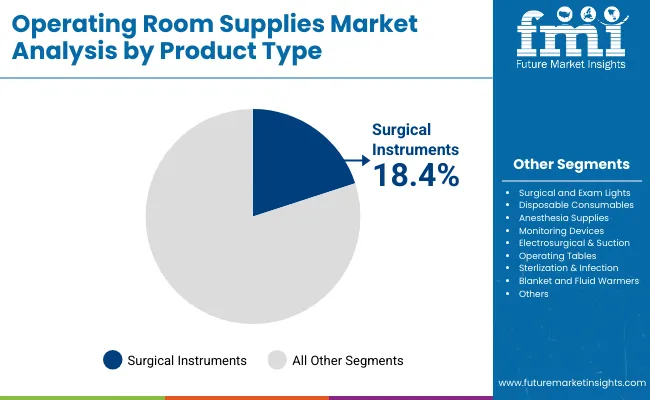
| Product Type | Market Share (%) |
|---|---|
| Surgical and Exam Lights | 6.5% |
| Surgical Instruments | 18.4% |
| Disposable Consumables | 17.2% |
| Anesthesia Supplies | 10.4% |
| Monitoring Devices | 7.4% |
| Electrosurgical & Suction | 6.7% |
| Operating Tables | 15.8% |
| Sterilization & Infection | 5.9% |
| Blanket and Fluid Warmers | 4.7% |
| Others | 7.0% |
Surgical Instruments are expected to retain a leading position within the Operating Room Supplies Market, contributing approximately 18.4% of the total market value in 2025. This dominance is attributed to their essential role across nearly all surgical procedures, ranging from general and orthopedic surgeries to specialized disciplines such as neurosurgery and cardiothoracic interventions.The sustained demand for surgical instruments is being driven by the global rise in surgical volumes, increasing focus on procedure standardization, and the transition toward minimally invasive and robotic-assisted techniques, which require precise, high-performance tools. Healthcare providers are prioritizing high-quality, reusable instruments that offer durability, ergonomic design, and compatibility with modern sterilization protocols.

| Procedure Type | Market Share (%) |
|---|---|
| General Surgery | 27.9% |
| Orthopedic Surgery | 22.1% |
| Cardiothoracic Surgery | 11.4% |
| Neurosurgery | 7.8% |
| Plastic & Reconstructive Surgery | 6.0% |
| Ophthalmic Surgery | 5.6% |
| Obstetrics & Gynecology Surgery | 7.5% |
| Urological Surgery | 5.6% |
| Others | 6.1% |
General Surgery has emerged as the leading procedure type within the Operating Room Supplies Market, projected to hold approximately 27.9% share in 2025. This dominant position is driven by the consistently high volume of general surgical procedures worldwide, spanning emergency, elective, and minimally invasive surgeries. The increasing prevalence of chronic diseases, growing aging populations, and rising demand for ambulatory and outpatient surgeries are significant contributors to this segment’s growth. Hospitals and surgical centers are investing heavily in specialized operating room supplies tailored to general surgery needs, including versatile surgical instruments, advanced lighting systems, and ergonomic operating tables designed for diverse procedural requirements.
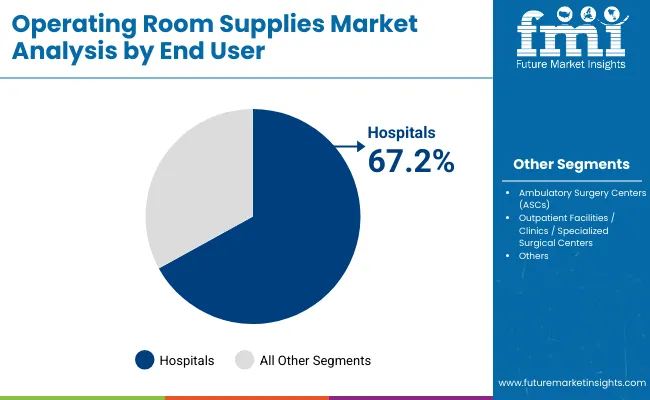
| End User | Market Share (%) |
|---|---|
| Hospitals | 67.2% |
| Ambulatory Surgery Centers (ASCs) | 18.9% |
| Outpatient Facilities / Clinics / Specialized Surgical Centers | 9.3% |
| Others | 4.6% |
Hospitals are expected to remain the largest end user segment, contributing approximately 67.2% of the Operating Room Supplies Market in 2025. This dominant share is driven by the concentration of complex surgical interventions and high-acuity procedures typically performed within hospital settings, which require comprehensive, regulation-compliant operating room infrastructure.The demand for advanced surgical supplies in hospitals is reinforced by stringent infection control mandates, the need for standardized sterilization and reprocessing workflows, and growing procedural volumes. Hospitals are investing significantly in modernizing operating rooms and central sterile supply departments (CSSDs) with scalable, high-efficiency equipment such as ceiling-mounted surgical lights, electrosurgical devices, and disposable consumables to support diverse surgical specialties.
Rising Surgical Volumes and Aging Population
The global population is aging at an unprecedented rate. In 2023, there were approximately 1.1 billion individuals aged 60 and older worldwide, and this number is projected to increase to 1.4 billion by 2030. This demographic shift is particularly pronounced in developing regions, where longer life expectancies and decreasing birth rates contribute to a higher proportion of elderly individuals.
Older adults are more susceptible to chronic conditions such as cardiovascular diseases, osteoarthritis, and cancer, which often require surgical interventions. As a result, healthcare systems are witnessing a higher demand for surgical procedures, thereby driving the need for advanced operating room supplies to accommodate the specific requirements of geriatric care.
High Cost of Advanced Operating Room Equipment
The acquisition and installation of sophisticated operating room equipment often involve substantial upfront investments. For instance, setting up a fully equipped modern operating room can cost between $500,000 and $3 million, depending on the complexity and type of equipment installed. This includes expenses for hybrid imaging systems, robotic surgical systems, and integrated digital platforms. Such high capital expenditures pose a significant financial burden, especially for small and mid-sized healthcare facilities with limited budgets. Moreover, the ongoing maintenance costs add to the financial strain. Advanced equipment requires regular servicing, calibration, software updates, and specialized training for healthcare professionals. These recurring expenses can deter healthcare institutions from investing in new technologies, limiting the market's growth potential.
Integration of Digital and Smart Technologies
The integration of digital and smart technologies is a transformative trend propelling the growth of the global Operating Room (OR) Supplies Market. Hospitals and surgical centers are increasingly adopting advanced digital solutions to enhance surgical precision, improve patient outcomes, and optimize operational efficiency.
Hospitals are increasingly incorporating advanced imaging systems such as 4K and 3D imaging into operating room integration solutions to enhance surgical precision and outcomes. Additionally, the integration of Artificial Intelligence (AI) and Machine Learning (ML) into operating room systems is improving decision-making, automating workflows, and enhancing data analytics capabilities.
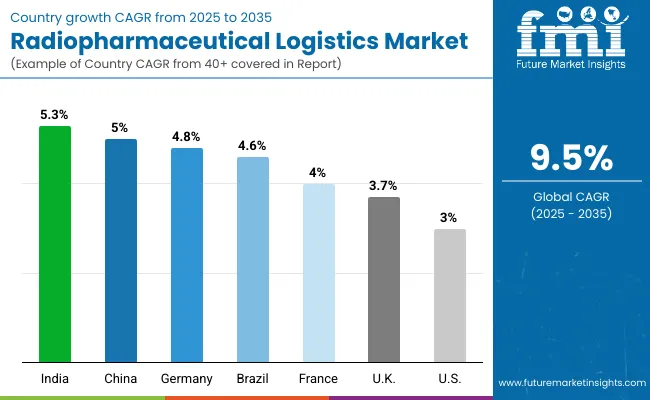
| Countries | CAGR |
|---|---|
| USA | 3.0% |
| Brazil | 4.6% |
| China | 5.0% |
| India | 5.3% |
| Europe | 2.3% |
| Germany | 4.8% |
| France | 4.0% |
| UK | 3.7% |
Asia Pacific is emerging as the fastest-growing region in the Operating Room Supplies Market, projected to grow at a CAGR of approximately 5.0% to 5.3% between 2025 and 2035. Key countries such as India and China are driving this growth, with India expected to grow at 5.3% CAGR and China at 5.0% CAGR. This growth is fueled by rapid expansion of healthcare infrastructure, increasing surgical volumes, and rising investments in modernizing surgical facilities across Tier 1 and Tier 2 cities. Additionally, government initiatives aimed at improving healthcare access and infection control protocols especially post-pandemic, are accelerating demand for advanced operating room supplies. Hospitals and ambulatory surgery centers in these countries are upgrading operating rooms with advanced surgical instruments, monitoring devices, and anesthesia supplies to meet rising patient volumes and enhance surgical outcomes.
Europe is forecasted to grow steadily at around 2.3% CAGR through 2035, with Germany, France, and the UK as key contributors. Germany is expected to expand at 4.8% CAGR, benefiting from investments in digital operating room technologies and automation in surgical workflows. France, supported by healthcare reforms and hospital modernization programs, is projected at 4.0% CAGR, while the UK will see growth near 3.7% CAGR, driven by NHS initiatives targeting improvements in surgical efficiency and patient safety. The European market is bolstered by stringent infection control standards, continuous professional training, and a shift towards integrated surgical suites equipped with advanced electrosurgical and monitoring devices.
North America remains a mature but innovation-driven market, with the USA projected to grow at a 3.0% CAGR from 2025 to 2035. The market expansion is supported by a steady increase in surgical procedures and the replacement of outdated operating room equipment with digitally integrated and ergonomic solutions. Hospitals and ambulatory surgical centers are investing heavily in advanced surgical lights, disposable consumables, and electrosurgical devices to improve workflow efficiency and patient outcomes. Additionally, regulatory compliance with infection control standards and safety protocols is driving demand for specialized operating room supplies. Federal funding for hospital upgrades and a growing focus on outpatient surgeries further contribute to sustained market growth.
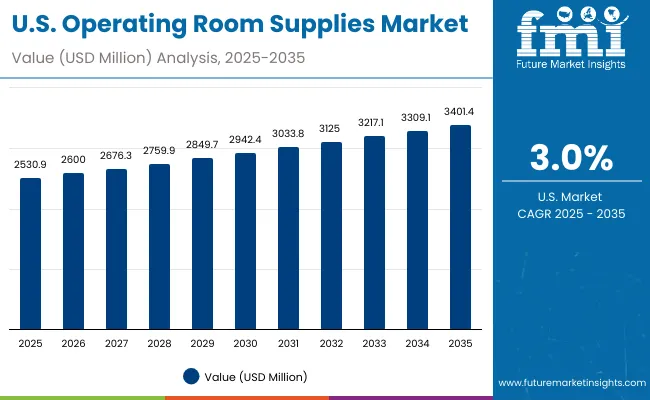
The Operating Room Supplies Market in the USA is forecasted to grow at a 3.0% CAGR between 2025 and 2035, driven primarily by rising surgical volumes, regulatory mandates on infection control, and increasing investments in modern surgical infrastructure. Hospitals and ambulatory surgical centers (ASCs) are actively upgrading legacy operating rooms with advanced surgical instruments, anesthesia supplies, and monitoring devices to improve surgical outcomes and workflow efficiency.
The Operating Room Supplies Market in the United Kingdom is projected to grow at a CAGR of approximately 3.7% through 2035, driven by ongoing NHS initiatives aimed at modernizing surgical infrastructure and enhancing patient safety. Programs such as the “New Hospital Programme” and the broader Health Infrastructure Plan (HIP) continue to channel significant investment into upgrading operating rooms across NHS Trust hospitals, emphasizing infection control, workflow efficiency, and compliance with surgical site infection (SSI) reduction targets.
The Operating Room Supplies Market in Germany is forecasted to grow at a CAGR of approximately 4.8% through 2035, driven by substantial federal funding under the Krankenhauszukunftsgesetz (Hospital Future Act), which supports modernization of surgical facilities and operating room infrastructure. German hospitals, characterized by high surgical volumes and rigorous infection control protocols, are increasingly investing in advanced operating room supplies such as ergonomic surgical instruments, ceiling-mounted surgical lights, anesthesia equipment, and digital monitoring systems.
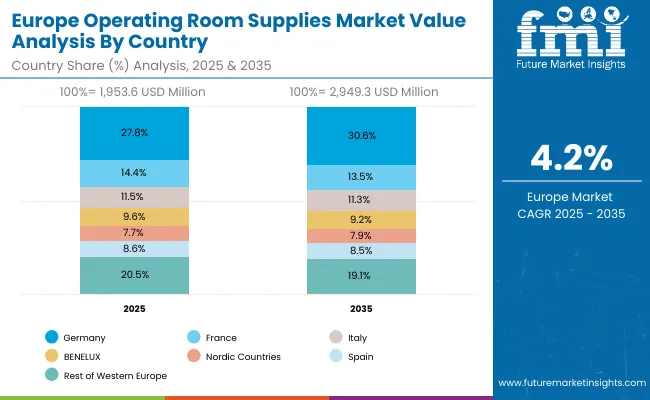
| Europe Countries | 2025 |
|---|---|
| Germany | 27.8% |
| France | 14.4% |
| Italy | 11.5% |
| BENELUX | 9.6% |
| Nordic Countries | 7.7% |
| Spain | 8.6% |
| Rest of Western Europe | 20.5% |
| Germany | 27.8% |
| Europe Countries | 2035 |
|---|---|
| Germany | 30.6% |
| France | 13.5% |
| Italy | 11.3% |
| BENELUX | 9.2% |
| Nordic Countries | 7.9% |
| Spain | 8.5% |
| Rest of Western Europe | 19.1% |
| Germany | 30.6% |
The Operating Room Supplies Market in India is expected to grow at a robust CAGR of approximately 5.3% through 2035, making it one of the fastest-growing regional markets globally. This growth is driven by the rapid expansion of tertiary care hospitals, medical colleges, and private surgical centers, particularly in Tier 1 and Tier 2 cities. Increasing surgical volumes coupled with rising awareness around infection control and compliance with NABH (National Accreditation Board for Hospitals & Healthcare Providers) standards are accelerating the adoption of advanced operating room supplies.
The Operating Room Supplies Market in China is projected to grow at a strong CAGR of approximately 5.0% through 2035, driven by large-scale investments in hospital infrastructure under the government’s Healthy China 2030 initiative. Regulatory bodies, including the National Health Commission, have tightened standards around surgical suite equipment and infection control protocols, accelerating the adoption of advanced operating room supplies such as ceiling-mounted surgical lights, surgical instruments, anesthesia supplies, and digital monitoring devices.
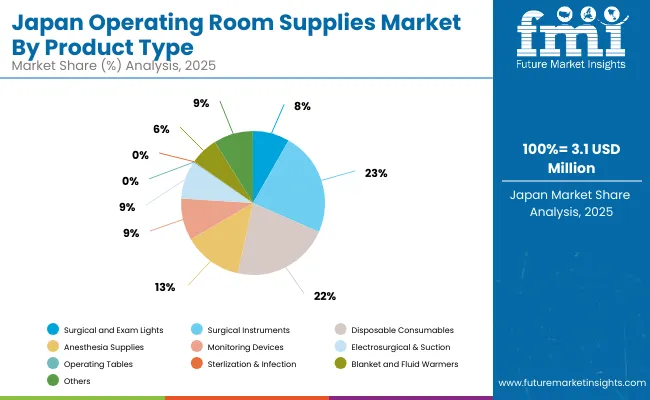
The Operating Room Supplies Market in Japan is projected to reach USD 316.8 million, reflecting the country's focus on advanced surgical technology integration and stringent healthcare standards. Surgical Instruments contributes a18.4% in 2025. The product type segment exhibits a diverse distribution driven by Japan’s emphasis on high-quality surgical outcomes and operational efficiency within operating rooms.
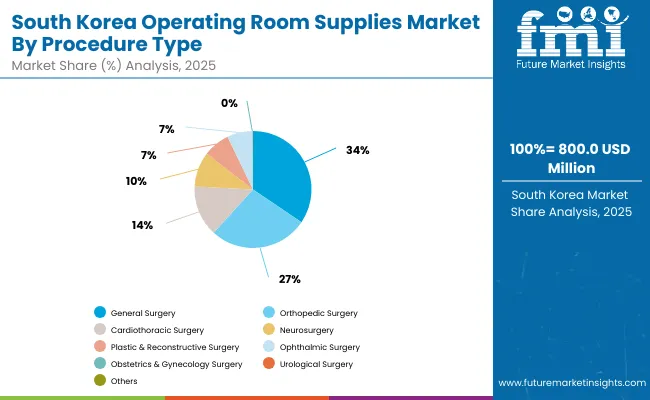
The Operating Room Supplies Market in South Korea is estimated to reach USD 227.5 million by 2025, with hospitals dominating the end-user segment, accounting for approximately 72.4% of the market share. This dominance reflects South Korea’s robust healthcare infrastructure, where most surgical procedures and high-risk medical interventions take place within hospital settings.
Key drivers for hospital demand include government mandates for infection control, modernization of surgical departments, and investments in advanced operating room technologies to improve procedural efficiency and patient safety.
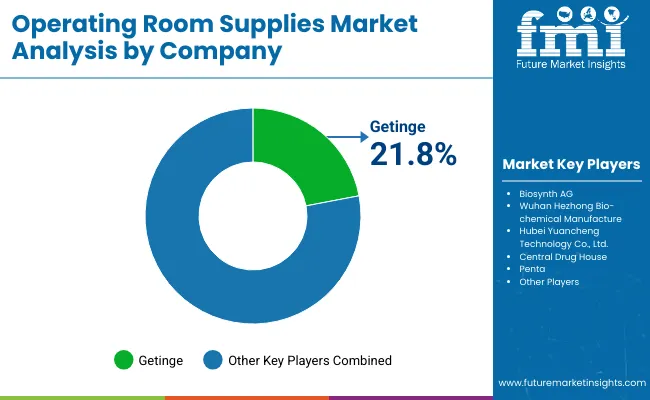
The Operating Room Supplies Market is moderately fragmented, characterized by a mix of global giants, specialized OEMs, and emerging regional manufacturers competing across surgical lights, instruments, anesthesia supplies, and operating room integration systems.
Getinge AB leads the global market, commanding a 21.8% revenue share in 2025. The company’s dominance is rooted in its full-spectrum operating room solutions, including surgical tables, integrated OR systems, and ceiling supply units. Its strategy centers on offering turnkey OR ecosystems that are fully compliant with hygiene and ergonomic standards. Getinge continues to grow through acquisitions and digital innovations, such as modular OR integration platforms and infection control-aligned equipment.
As global surgical volumes rise and cost pressures increase, competitive differentiation is shifting away from standalone equipment toward digitally integrated operating environments, including:
Key Developments
| Item | Value |
|---|---|
| Quantitative Units | USD 8,123.8 million |
| Product type | Surgical and Exam Lights, Surgical Instruments, Disposable Consumables, Anesthesia Supplies, Monitoring Devices, Electrosurgical & Suction, Operating Tables, Sterilization & Infection, Blanket and Fluid Warmers and Others |
| Procedure Type | General Surgery, Orthopedic Surgery, Cardiothoracic Surgery, Neurosurgery, Plastic & Reconstructive Surgery, Ophthalmic Surgery, Obstetrics & Gynecology Surgery, Urological Surgery, and Others |
| End User | Hospitals, Ambulatory Surgery Centers (ASCs), Outpatient Facilities / Clinics / Specialized Surgical Centers, and Others |
| Regions Covered | North America, Latin America, Western & Eastern Europe, East Asia, South Asia & Pacific, Middle East & Africa |
| Countries Covered | USA, Brazil, China, India, Germany, France, UK etc. |
| Key Companies Profiled | Getinge, Codex Healthcare, United Surgical, Makler Surgical Lights & Lights Techn ology LLC., Famed Łódź S.A., Baxter, AGA Sanitätsartikel GmbH, OPT SURGISYSTEMS S.R.L., Burton Medical, LLC., Drägerwerk AG & Co. KGaA, Zhangjiagang Medi Medical Equipment Co., Ltd., MedTerm, CooperSurgical, Inc., STERIS, Masimo, Gentherm, Henan Joinkona Medical Products Stock Co.,Ltd., DIXION Company, SternMed GmbH, and BRUMABA GmbH & Co. KG |
| Additional Attributes | Dollar sales by Product Type and region s, adoption trends of Integration of Digital and Smart Technologies, and Rising Surgical Volumes and Aging Population is driving the growth of the market. |
The global Operating Room Supplies Market is estimated to be valued at USD 8,123.8 million in 2025.
The market size for Operating Room Supplies Market is projected to reach USD 11,683.0 million by 2035.
The Operating Room Supplies Market is expected to grow at a CAGR of 3.7% during this period.
Key product types include Surgical and Exam Lights, Surgical Instruments, Disposable Consumables, Anesthesia Supplies, Monitoring Devices, Electrosurgical & Suction, Operating Tables, Sterilization & Infection, Blanket and Fluid Warmers and Others.
The Hospital Sterile Compounding segment is projected to command 27.9% of the market in 2025.






Our Research Products

The "Full Research Suite" delivers actionable market intel, deep dives on markets or technologies, so clients act faster, cut risk, and unlock growth.

The Leaderboard benchmarks and ranks top vendors, classifying them as Established Leaders, Leading Challengers, or Disruptors & Challengers.

Locates where complements amplify value and substitutes erode it, forecasting net impact by horizon

We deliver granular, decision-grade intel: market sizing, 5-year forecasts, pricing, adoption, usage, revenue, and operational KPIs—plus competitor tracking, regulation, and value chains—across 60 countries broadly.

Spot the shifts before they hit your P&L. We track inflection points, adoption curves, pricing moves, and ecosystem plays to show where demand is heading, why it is changing, and what to do next across high-growth markets and disruptive tech

Real-time reads of user behavior. We track shifting priorities, perceptions of today’s and next-gen services, and provider experience, then pace how fast tech moves from trial to adoption, blending buyer, consumer, and channel inputs with social signals (#WhySwitch, #UX).

Partner with our analyst team to build a custom report designed around your business priorities. From analysing market trends to assessing competitors or crafting bespoke datasets, we tailor insights to your needs.
Supplier Intelligence
Discovery & Profiling
Capacity & Footprint
Performance & Risk
Compliance & Governance
Commercial Readiness
Who Supplies Whom
Scorecards & Shortlists
Playbooks & Docs
Category Intelligence
Definition & Scope
Demand & Use Cases
Cost Drivers
Market Structure
Supply Chain Map
Trade & Policy
Operating Norms
Deliverables
Buyer Intelligence
Account Basics
Spend & Scope
Procurement Model
Vendor Requirements
Terms & Policies
Entry Strategy
Pain Points & Triggers
Outputs
Pricing Analysis
Benchmarks
Trends
Should-Cost
Indexation
Landed Cost
Commercial Terms
Deliverables
Brand Analysis
Positioning & Value Prop
Share & Presence
Customer Evidence
Go-to-Market
Digital & Reputation
Compliance & Trust
KPIs & Gaps
Outputs
Full Research Suite comprises of:
Market outlook & trends analysis
Interviews & case studies
Strategic recommendations
Vendor profiles & capabilities analysis
5-year forecasts
8 regions and 60+ country-level data splits
Market segment data splits
12 months of continuous data updates
DELIVERED AS:
PDF EXCEL ONLINE
Operating Room Management Software Market Size and Share Forecast Outlook 2025 to 2035
Operating Room Equipment Market Analysis - Growth & Forecast 2025 to 2035
Mobile Operating Rooms Market Analysis – Size, Trends & Forecast 2025 to 2035
Bedroom Furniture Market
Mushroom Stems Market Size and Share Forecast Outlook 2025 to 2035
Mushroom-Based Animal Feed Market Size and Share Forecast Outlook 2025 to 2035
Mushroom Packaging Market Size and Share Forecast Outlook 2025 to 2035
Mushroom-Powered Skincare Market Analysis - Size, Share, and Forecast Outlook 2025 to 2035
Bathroom Furniture Market Size and Share Forecast Outlook 2025 to 2035
Mushroom-Based Snacks Market Analysis - Size and Share Forecast Outlook 2025 to 2035
Mushroom Supplement Market Size and Share Forecast Outlook 2025 to 2035
Bathroom Cabinets Market Size and Share Forecast Outlook 2025 to 2035
Bathroom Remodeling Market Size and Share Forecast Outlook 2025 to 2035
Bathroom Mirror Wiper Market Size and Share Forecast Outlook 2025 to 2035
Bathroom Vanities Market Analysis - Growth, Trends and Forecast from 2025 to 2035
Mushroom Beer Market Trends - Brewing Innovation & Consumer Growth 2025 to 2035
Bathroom Worktops Market Analysis - Trends & Forecast 2025 to 2035
Competitive Overview of Mushroom Packaging Companies
Mushroom Fermenter Market Growth – Production & Demand 2025 to 2035
Mushroom Materials Market Growth – Trends & Forecast 2024-2034

Thank you!
You will receive an email from our Business Development Manager. Please be sure to check your SPAM/JUNK folder too.
Chat With
MaRIA